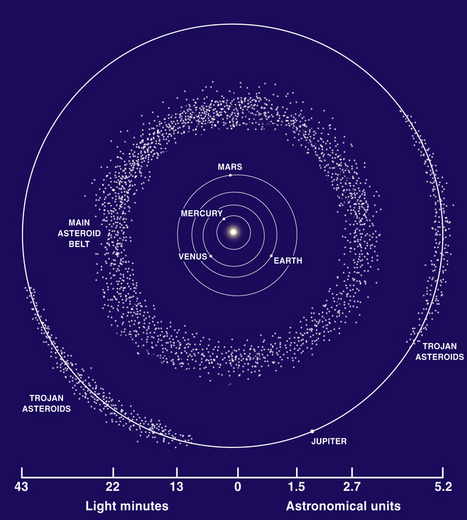Asteroid occultation ephemerides

PHOTO CAPTION GALILEO June 11, 1992 P-40450-C TOP GLL/GA5 This picture of asteroid 951 Gaspra is a combination of the highest-resolution morphology and color information obtained by the Galileo spacecraft during its approach to the asteroid on October 29, 1991. The Sun is shining from the right; phase angle is 50 degrees. The base image is the best black-and-white view of Gaspra (resolution 54 meters/pixel) on which are superimposed the subtle color variations constructed from violet, green, and near-infrared (1000 nanometers) inages taken in an earlier sequence at a resolution about 164 meters/pixel.
They are thought to be the leftovers from the formation of the solar system 4.6 billion years ago, and hang out in a vast ring between the orbits of Jupiter and Mars.

The asteroid belt lies in the region between Mars and Jupiter. The Trojan asteroids lie in Jupiter's orbit, in two distinct regions in front of and behind the planet. Image Credit: Lunar and Planetary Institute Credit: Lunar and Planetary Institute
We have imaged them with space probes, and telescopes but those are not the only methods to discover cool things about distant objects.
At a recent meeting of the Durban Astronomical Society of South Africa, my good buddy Nigel Wakefield explained an alternate way of imaging asteroids – occultations.
Basically, when a celestial object, like a planet or asteroid passes in front of the light of a distant star we call that an occultation, and we can use the timing of the blocking of the stars light by the object, and its reappearance from behind the object to map out the shape of that object. If the occultation is visible from your location you are said to be in the shadow path of the event.
Using this method is kinda like a large scale human scanner – it looks for a dark object blocking out the bright light of a star for anywhere from a fraction of a second to almost a minute, and using that data we can construct a line delineating the shape of the object for a moment. The other vital part of this process is that we have multiple observers from multiple different locations within the path of the occultation observing and faithfully recording their slightly different experiences of the object occulting the star’s light. What this does is give us a data set with a number of observation lines which when mapped out, can give us some idea of the shape of the occulting asteroid.
Steve Preston over at this site:
http://www.poyntsource.com/New/Global.htm
provides predictions for various locations and occultations. He uses an ephemerides calculation to predict the occultation and resultant shadow path on the Earth. You can download cool images of the predicted path of the shadow on the Earths surface as the asteroid occults the light of a particular star. This one is for Overberg in the Cape.
So how do you know when an asteroid is going to occult a specific star? Well, in order to make your own predictions you need to learn how to use the Occult program available on the site mentioned above. That lets you specify your location and provides predictions of occultation paths that traverse your specific location.
There is a nice help FAQ here: http://www.asteroidoccultation.com/asteroid_help.htm
Then you need a timing method – we are planning to use a radio station correlated with a known timing source and video of the observation, and the observer reporting what he/ she sees through the eye piece (star gone, star back) to build our observation data.
This is what an observation file looks like, with lines delineating separate observers data collated to form the image of the asteroid:
You can even create your own plots in Google Earth:
All my observation opportunities so far have been frustrated by cloud, but any clear observations will be reported here.
My great thanks go to Nigel Wakefield for introducing me to this fascinating subject.





While I was having a leisurely pee on my lawn earlier this evening, something occulted the the Moon. Fortunately it was moving quite slowly so I was able to determine the shape quite clearly. I looked to me much like some old biddy on a broomstick, but then it was difficult to judge her age at that distance.